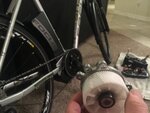Ravi Kempaiah
Well-Known Member
- Region
- Canada
- City
- Halifax
My friend, Adam has put together this awesome, scientific video comparison between his two drive systems.
Few months ago, he published this excellent article about commuting on E-bikes and cheating.
There is an existing notion that mid-drives are better hill climbers. That's true with a caveat. It's only in slow, technical off-road conditions, mid-drives help you with extra torque but on road and paved surfaces, hub motors win hands down.
A well tuned hub motor is easy on the drive parts and is reliable. ST2 has controller in the downtube unlike ST1, which eliminates controller failure and helps heat dissipation.
Look at the stats. Great video.
Also, people who were quoting Torque numbers like 90Nm, 80Nm Vs ST2's 35Nm, I welcome your dissenting voice.
Few months ago, he published this excellent article about commuting on E-bikes and cheating.
There is an existing notion that mid-drives are better hill climbers. That's true with a caveat. It's only in slow, technical off-road conditions, mid-drives help you with extra torque but on road and paved surfaces, hub motors win hands down.
A well tuned hub motor is easy on the drive parts and is reliable. ST2 has controller in the downtube unlike ST1, which eliminates controller failure and helps heat dissipation.
Look at the stats. Great video.
Also, people who were quoting Torque numbers like 90Nm, 80Nm Vs ST2's 35Nm, I welcome your dissenting voice.
